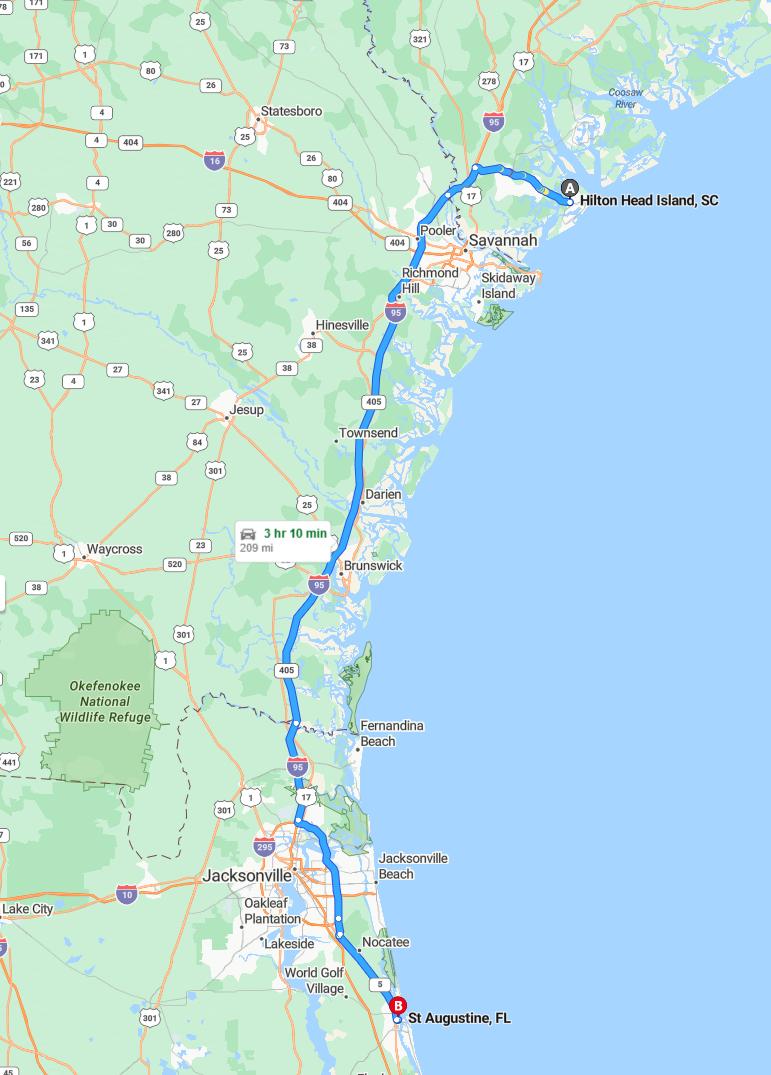Distance and estimated driving time
The drive from Hilton Head Island to St. Augustine covers approximately 209 miles and is estimated to take around 3 hours and 10 minutes. The most common route involves traveling south on I-95, with a brief detour onto I-295 S for traffic management and convenience. This scenic and efficient journey offers travelers a smooth transition between popular destinations along the southeastern coast. Be sure to check current traffic conditions before departure to ensure a timely arrival.
Driving route
Traveling from Hilton Head Island to St. Augustine offers a scenic journey through the southeastern Atlantic Coast, starting in South Carolina and moving through Georgia into northern Florida. The route includes key towns such as Savannah, known for its historic charm, and Richmond Hill, which provides a glimpse into coastal Georgia life. As travelers cross into Florida, Jacksonville offers urban attractions, followed by the charming beaches of Fernandina Beach. The trip concludes near Nocatee, Florida, making it an ideal scenic drive combining cultural sights and natural beauty en route to St. Augustine. This route showcases a mix of historic, coastal, and metropolitan experiences suitable for diverse travelers.

Best time to depart for optimal traffic conditions
For an optimal driving experience from Hilton Head Island to St. Augustine, it is best to depart early in the morning, ideally before 7:00 AM, to avoid peak traffic hours in bustling areas like Savannah and Jacksonville. Leaving at this time allows for smoother travel through the Georgia and Florida cities, minimizing delays caused by rush hour congestion. If an early departure isn't possible, consider leaving after 9:00 AM or during mid-afternoon hours, when traffic tends to be lighter. Planning your trip during weekdays rather than weekends can also help avoid additional holiday or weekend traffic, ensuring a more comfortable and efficient journey.
Roadside attractions along the route
Traveling from Hilton Head Island to St. Augustine offers a variety of roadside attractions that enhance the journey. In Savannah, visitors can explore historic squares and the iconic Forsyth Park, offering picturesque views and cultural experiences. Near Jacksonville, the Jacksonville Zoo and Gardens provides family-friendly entertainment, while Fernandina Beach features charming Victorian architecture and scenic waterfront parks. Additionally, roadside diners and unique local shops along the route afford travelers a taste of regional flavors and small-town charm, making the trip both enjoyable and memorable.
Food and dining options during the drive
During the drive from Hilton Head Island to St. Augustine, travelers have a variety of dining options along the route. In Hilton Head Island, local seafood restaurants offer fresh catches, while Pooler and Savannah, GA, feature numerous casual cafes and southern-style eateries. As you approach Jacksonville, FL, you'll find diverse cuisines, from traditional Southern barbecue to international dishes, with many restaurants providing quick-service or sit-down options. Near Fernandina Beach and Nocatee, charming cafes and waterfront dining spots offer relaxing environments to enjoy fresh seafood and regional specialties, making the journey both delicious and memorable.
Accommodation suggestions near St. Augustine
For travelers heading to St. Augustine, there are a variety of excellent accommodation options to suit different preferences. Historic inns and boutique hotels in the heart of the city provide a charming atmosphere, allowing visitors to immerse themselves in the area's rich history. For more modern comforts, beachfront resorts offer stunning ocean views and easy access to the coast, perfect for relaxing after a day of sightseeing. Additionally, numerous vacation rentals and cozy bed-and-breakfast establishments are available nearby, ensuring a comfortable and personalized stay for every traveler.
Essential travel tips and safety reminders
When traveling from Hilton Head Island to St. Augustine, it's important to plan ahead by ensuring your vehicle is well-maintained and fueled before beginning your journey. Stay alert to road signs and speed limits, especially when crossing multiple jurisdictions like Georgia and Florida, and take regular breaks to avoid fatigue. Keep your belongings secure and be cautious of local traffic laws to ensure a safe trip through cities such as Savannah, Jacksonville, and Fernandina Beach. Lastly, stay updated on weather conditions and any road advisories to navigate smoothly and arrive at your destination safely.
Weather forecast for the travel dates
The weather forecast for the travel dates from Hilton Head Island to St. Augustine indicates generally warm and mild conditions across the route, with daytime temperatures in the 70s and 80s Fahrenheit. Travelers can expect occasional scattered showers, particularly in the coastal areas of Savannah, Jacksonville, and Fernandina Beach, so it is advisable to carry rain gear. Humidity levels are likely to be elevated, contributing to a sticky atmosphere, especially in Georgia and northern Florida. Overall, travelers should prepare for a mix of sunshine and showers, ensuring a comfortable and safe journey along this scenic route.
Fuel stations and vehicle maintenance tips
When driving from Hilton Head Island to St. Augustine, it's essential to plan for fuel stops along the route, which includes cities like Savannah, Jacksonville, and Fernandina Beach. Make sure to fill up your tank before long stretches, especially in areas with fewer service stations such as Richmond Hill and Hinesville. Regular vehicle maintenance, including checking tire pressure, oil levels, and brakes, can help prevent breakdowns during your trip. Additionally, carrying a roadside emergency kit and ensuring your vehicle's fluid levels are topped off will contribute to a safe and smooth journey.
Local laws and driving regulations to note
When driving from Hilton Head Island to St. Augustine, travelers should be aware of various local laws and driving regulations along the route. In Georgia, it is important to observe speed limits, especially in school zones and construction areas, and to use headlights during inclement weather or at night. Florida requires all drivers to carry valid proof of insurance and adhere to strict DUI laws, with penalties for violations being severe. Additionally, both states enforce laws against distracted driving, such as texting while operating a vehicle, and mandate seatbelt use for all occupants, ensuring safer travel across state lines.
